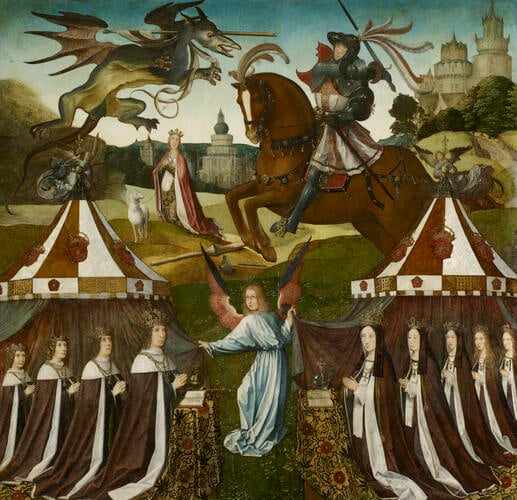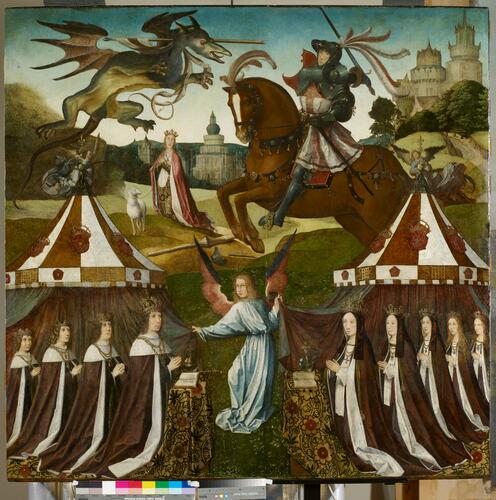-
1 of 253523 objects
The Family of Henry VII with St George and the Dragon c. 1503-9
Oil on panel | 145.6 x 142.6 cm (support, canvas/panel/stretcher external) | RCIN 401228

Flemish School, 16th century
The Family of Henry VII with St George and the Dragon c. 1503-9

Flemish School, 16th century
The Family of Henry VII with St George and the Dragon c. 1503-9


-
In a landscape with two fantastic buildings St George attacks the dragon before Princess Cleodolinde; in the foreground are two tents with angels holding open the flaps to reveal Henry VII and Elizabeth of York kneeling with their children.
This was probably originally an altarpiece, possibly for the royal chapel at Richmond Palace. There are no signs on the left and right sides of the panel to indicate that it would have had wings, so it may have been an unusual single-panel square format stand-alone altar panel, perhaps to be set into the wall behind an altar. It shows Henry VII and Elizabeth of York united by an angel. Their children are shown to either side, the sons on the left behind their father and the daughters on the right behind their mother. Of the princes, only Henry was alive at the time the painting was made (c.1503-9); Edmund died aged 1 and Arthur died in 1502. Elizabeth of York died in 1503 following the birth of Princess Catherine, who only lived for a few hours. The eldest two princesses were alive, but Mary died very young. These figures thereby symbolise the progeny of Henry VII and Elizabeth of York and symbolise the new Tudor dynasty, rather than functioning as realistic portraits. The King and Queen kneel at prayer desks on which Henry VII has a prayer book, orb and sceptre, and Elizabeth of York has a prayer book.
In the fantastical landscape dominating the top half of the painting, St George is shown mid-fight slaying the dragon. The dragon was often used by Henry VII as a symbol of his Welsh heritage. In this instance the symbolic emphasis is on St George as patron saint of England, and one of the three saints of the Order of the Garter.
The story of St George and the Dragon from Jacobus de Voragine’s 'Golden Legend' tells of the Princess Cleodoline who is about to be sacrificed to the dragon when she is saved by the heroic warrior George. She is shown here with a lamb which is emblematic of her sacrifice.
The figure of Saint George seems to protect the royal family below and the royal figures function as donor portraits. The angel hold open the flaps of tents which are reminiscent of tents on a battle field or tournament tents. The Lancastrian red rose and the portcullis of the Beaufort family (the mother of Henry VII) are emblazoned on the tents. The red and white colours are those of both St George and of Lancastrian livery.
Although this painting didn’t enter the Royal Collection until 1883 when it was purchased by Queen Victoria, it is most likely that it was commissioned directly by Henry VII from a Flemish artist working at his court. It is first recorded by Vertue in 1726 in Tart Hall. It was later in the collection of James West. It was bought by Horace Walpole in 1773 and recorded in his collection at Strawberry Hill where he mistakenly identified the sitters as Henry V and his family, probably because of the famous link between Henry V and St George, immortalised by Shakespeare in the Agincourt speech in the play 'Henry V'.Provenance
Purchased by Queen Victoria in 1883
-
Creator(s)
Acquirer(s)
-
Medium and techniques
Oil on panel
Measurements
145.6 x 142.6 cm (support, canvas/panel/stretcher external)
Category
Object type(s)